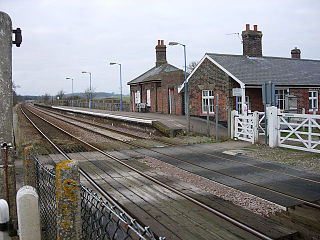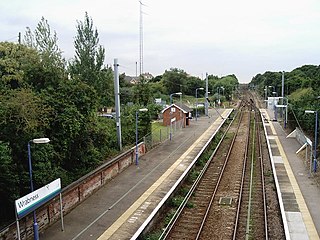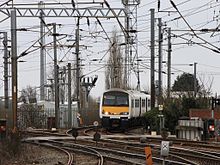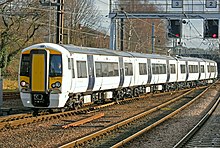
The Great Eastern Main Line is a 114.5-mile (184.3 km) major railway line on the British railway system which connects Liverpool Street station in central London with destinations in east London and the East of England, including Shenfield, Chelmsford, Colchester, Ipswich and Norwich. Its numerous branches also connect the main line to Southminster, Braintree, Sudbury, Harwich and a number of coastal towns including Southend-on-Sea, Clacton-on-Sea, Walton-on-the-Naze and Lowestoft.

Reedham railway station is on the Wherry Lines in the East of England, serving the village of Reedham, Norfolk. It is 12 miles 13 chains (19.6 km) down the line from Norwich and is situated between Cantley to the west and, to the east, Berney Arms on the Great Yarmouth branch or Haddiscoe on the Lowestoft branch. It is commonly suffixed as Reedham (Norfolk) in order to distinguish it from the station of the same name in south London. Its three-letter station code is REE.

Norwich railway station is the northern terminus of the Great Eastern Main Line in the East of England, serving the city of Norwich, Norfolk. It is 114 miles 77 chains (185.0 km) down the main line from London Liverpool Street, the western terminus.

Ipswich railway station is on the Great Eastern Main Line in the East of England, serving the town of Ipswich, Suffolk. It is 68 miles 59 chains (110.6 km) down the line from London Liverpool Street and, on the main line, it is situated between Manningtree to the south and Needham Market to the north.

The Eastern Union Railway (EUR) was an English railway company, at first built from Colchester to Ipswich; it opened in 1846. It was proposed when the earlier Eastern Counties Railway failed to make its promised line from Colchester to Norwich. The businessman John Chevallier Cobbold and the engineer Peter Bruff were prominent in launching the company. The allied but nominally independent Ipswich and Bury Railway built a line onwards to Bury St Edmunds, also opening in 1846, and soon amalgamated with the EUR.

The Ipswich–Ely line is a railway line linking East Anglia to the English Midlands via Ely. There is also a branch line to Cambridge. Passenger services are operated by Abellio Greater Anglia. It is a part of Network Rail Strategic Route 5, SRS 05.07, 05.08 and part of SRS 07.03. The line has previously been part of the Great Eastern Main Line.

Wickham Market railway station is on the East Suffolk Line in the east of England, located in Campsea Ashe, Suffolk, approximately 2 miles (3.2 km) east of Wickham Market itself. The station is 15 miles 64 chains (25.4 km) down the line from Ipswich and 84 miles 43 chains (136.0 km) measured from London Liverpool Street; it is situated between Melton and Saxmundham. Its three-letter station code is WCM.

Stowmarket railway station is on the Great Eastern Main Line (GEML) in the East of England, serving the town of Stowmarket, Suffolk. It is 80 miles 9 chains (128.9 km) down the line from London Liverpool Street and is situated between Needham Market to the south and Diss to the north. It is also the junction where the Ipswich to Ely Line joins the GEML. Its three-letter station code is SMK.

Harwich International railway station on the Mayflower Line, a branch of the Great Eastern Main Line, serves Harwich International Port in Essex, England. It is 68 miles 72 chains (110.88 km) from London Liverpool Street, between Wrabness to the west and Dovercourt to the east. Its three-letter station code, HPQ, derives from its original name, Harwich Parkeston Quay.

Buckenham railway station is on the Wherry Lines in the east of England, serving the village of Buckenham in Norfolk. It is 7 miles 62 chains (12.5 km) down the line from Norwich on the routes to Lowestoft and Great Yarmouth and is situated between Brundall and Cantley. Its three-letter station code is BUC.

Colchester railway station is on the Great Eastern Main Line (GEML) in the East of England, and is the primary station serving the city of Colchester, Essex. Its three-letter station code is COL. It is 51 miles 52 chains (83.1 km) down the line from London Liverpool Street and on the GEML is situated between Marks Tey to the west and Manningtree to the east. Colchester is also the location of a major junction where the GEML links to the Sunshine Coast Line, which runs south to Clacton-on-Sea and, via a short branch, to Walton-on-the-Naze; services to and from Colchester Town also join the GEML at the Colchester junction. The junction is grade-separated so trains branching to and from Colchester Town or the Sunshine Coast Line do not cross the main line.

Manningtree railway station is on the Great Eastern Main Line (GEML) in the East of England, serving the town of Manningtree, Essex. It is 59 miles 35 chains (95.66 km) down the line from London Liverpool Street and is situated between Colchester to the west and Ipswich to the east. The three-letter station code is MNG. It is also the western terminus of the Mayflower Line, a branch line to Harwich Town. The following station on the branch is Mistley.

Mistley railway station is on the Mayflower Line, a branch of the Great Eastern Main Line in the East of England, serving the village of Mistley, Essex. It is 61 miles 14 chains (98.45 km) down the line from London Liverpool Street and is situated between Manningtree to the west and Wrabness to the east. Its three-letter station code is MIS.

Wrabness railway station is on the Mayflower Line, a branch of the Great Eastern Main Line in the East of England, serving the village of Wrabness, Essex. It is 65 miles 6 chains (104.73 km) down the line from London Liverpool Street and is situated between Mistley to the west and Harwich International station to the east. Its three-letter station code is WRB.

Dovercourt railway station is on the Mayflower Line, a branch of the Great Eastern Main Line, in the East of England, serving the seaside town of Dovercourt, Essex. It is 70 miles 19 chains (113.04 km) from London Liverpool Street and is situated between Harwich International to the west and Harwich Town to the east. Its three-letter station code is DVC.

Harwich Town railway station is the eastern terminus of the Mayflower Line, a branch of the Great Eastern Main Line, in the East of England, serving the port town of Harwich, Essex. It is 70 miles 61 chains (113.88 km) from London Liverpool Street; the preceding station on the line is Dovercourt. Its three-letter station code is HWC.

Bentley railway station, also known as Bentley Junction between 1849 and 1878, was located in Bentley, Suffolk on the Great Eastern Main Line. It opened in 1846 and became a junction in 1847 when the Hadleigh Railway opened. The station was closed in 1966.
The Hadleigh Railway was a 7+1⁄2-mile (12.1 km) long single track branch railway line in Suffolk, England, that connected Hadleigh to the main line railway network at Bentley Junction. It was built by the nominally independent Eastern Union and Hadleigh Junction Railway company and opened in 1847. By the time of opening it had been taken over by the larger Eastern Union Railway.
Colchester engine shed was a motive power depot located in Colchester in the county of Essex in the UK. The original depot dated back to the opening of the Eastern Counties Railway (ECR) in 1843 and a second engine shed was built following the opening of the Eastern Union Railway in 1846. The ECR shed closed and the EUR shed was in use until November 1959 when the line was electrified and Colchester station rebuilt. A smaller two track engine shed was provided south of the station and after closure in the 1990s it was used for the stabling of diesel and electrical multiple units. It is currently known as Colchester Carriage Servicing Depot and units can be washed externally and cleaned internally on site.
Brantham TMD was to be a depot that was planned for Greater Anglia off the Great Eastern Main Line in Brantham. Construction was halted in April 2018 due to council concerns and in July 2019 planning permission was obtained for an alternative location between Dovercourt and Harwich International.





















